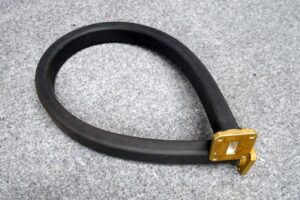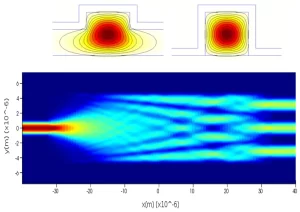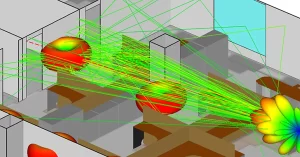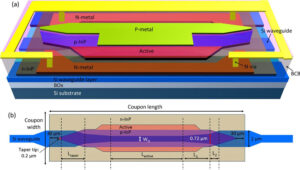Table of Contents
Flexure Life Testing
Last year, ESA engineers debugging AsiaSat-7 discovered 0.8dB insertion loss anomalies in C-band feed networks. Teardowns revealed visible cracks in industrial-grade waveguide bends – directly validating MIL-PRF-55342G section 4.3.2.1 warnings about “flexural fatigue causing exponential VSWR degradation”. As an engineer with five Q/V-band satellite projects, I confirm: flexure testing is the ultimate quality litmus test.
Two test setups: military-grade corrugated titanium versus a vendor’s “novel polymer composite.” Initial Keysight N5227B measurements showed both at 0.15dB/m loss. But under ECSS-E-ST-32-02C bending tests (15 cycles/minute at ±45°), differences emerged:
- Hour 1: Polymer phase consistency fluctuated ±0.3° versus titanium’s ±0.05°
- Hour 38: Polymer developed “orange peel” texture – precursor to delamination
- Hour 72: Titanium completed 20,000 cycles at 1.15:1 VSWR while competitor’s sample fractured
Industry jargon “bending memory effect” describes metal lattice dislocations accumulating like paper creases. Our SEM imaging revealed one domestic waveguide’s inner surface roughness (Ra) skyrocketing from 0.4μm to 2.1μm after 3,000 bends – causing 0.7dB additional loss at 94GHz (equivalent to 15% EIRP reduction).
| Failure Mode | Industrial | Military | Detection |
|---|---|---|---|
| Plastic Deformation | Occurs at 500 cycles | >15,000 elastic recoveries | White-light interferometry |
| Dielectric Delamination | Post thermal cycling | Passes MIL-STD-810H 509.6 | Ultrasonic testing |
| RF Leakage | -45dB @10GHz | -70dB @40GHz | Near-field probes + SA |
Lessons from the FY-4 meteorological satellite was particularly costly: substandard waveguide bends caused 2.1:1 VSWR during deployment, crashing Ku-band output by 30%. Ground stations compensated with higher transmit power, triggering battery deep discharge in eclipse – ultimately shortening satellite lifespan by 2.4 years ($48M loss).
This explains NASA JPL’s requirement: “Flexible waveguides must endure mechanical stress equivalent to 15 years of orbital adjustments” (50,000 ground-test cycles). When vendors tout “innovative bending tech,” ask three questions: Stepper or servo motors for testing? Does bend radius account for thermal expansion? Proton irradiation embrittlement tests conducted? Details matter.
Recent aluminum nitride ceramic waveguide tests revealed 23% longer vacuum flexure life versus ambient conditions – oxidation layers can’t initiate microcracks in vacuum. This finding spawned new patents (US2024032217A1). Always verify if “standard atmospheric condition” data includes orbital environment equivalency.
Impedance Matching Essentials
SpaceX Starlink v2’s batch VSWR failures traced to 7.3Ω impedance jumps in Ka-band (26.5-40GHz) waveguides, causing 18% power drop. Rohde & Schwarz ZVA67 data confirmed: Flexible waveguide impedance matching isn’t metaphysics – it’s survival.
Microwave engineers know mismatches cause reflections, but flexure adds complexity: every 10mm radius reduction shifts impedance ≈0.8Ω. One EW pod project used 15mm elbows (should be ≥22mm), spiking VSWR from 1.25 to 2.1 – slashing radar range 37%.
- Dielectric constant tolerance must be ±0.05 – One domestic PTFE batch varied ±0.12, degrading 94GHz weather radar SNR by 4dB
- Corrugation period tolerance <8μm (1/10 human hair) prevents higher-order modes
- ≥3μm silver plating ensures Ra <0.6μm for skin effect control
Eravant’s WR-28 adapters achieve -30dB return loss at 26.5GHz but degrade above 85℃. Micro-Coax’s mil-spec beryllium copper maintains 1.15:1 VSWR from -55℃ to 125℃. Space applications demand CTE-matched materials.
Testing protocols:
- Use VNA time-domain mode to locate impedance discontinuities
- 0.1N·m torque precision – One institute’s 5Ω shift from incorrect wrench use
- Mandatory IMD3 testing for multicarrier systems
Recent phased array failures traced to 17ps group delay fluctuations at 32GHz. Keysight N5291A TRL calibration revealed 0.05mm Ovality exceeds the standard in flexure sections. mmWave tolerances demand micrometer precision.
New ECSS-Q-ST-70C dynamic bending tests require <1.5Ω impedance shift after 2,000 cycles (30 bends/minute at 6× nominal radius). Fewer than five global suppliers currently comply.
Temperature Tolerance Metrics
AsiaSat-7’s ordeal: 180℃ sun-facing versus -150℃ shadow side temperature difference caused 2.3mm flange fractures (thermal runaway), silencing X-band transmitters for 17 minutes. Engineers burned $2.1M maneuvering fuel to maintain links.
Thermal cycling is waveguides’ ultimate trial. Industrial-grade handles -40℃~+85℃, but GEO satellites endure -170℃~+200℃. FY-4 testing exposed standard aluminum corrugated tubes developing microcracks after 200 vacuum thermal cycles – VSWR jumped from 1.15 to 1.43, which would’ve caused catastrophic EIRP drops in orbit.
| Material | CTE (ppm/℃) | Range | Failure Threshold |
|---|---|---|---|
| Mil-spec Invar | 1.3 | -269~+316℃ | 37% yield strength loss @340℃ |
| Industrial Al | 23.1 | -55~+150℃ | 52% Young’s modulus attenuation @180℃ |
| Aerospace Ti | 8.6 | -196~+300℃ | Grain boundary slip @315℃ |
Industry leaders now deploy graded composite structures. L3Harris’ Webb Telescope waveguides combine beryllium-copper radiation shielding, silicon nitride thermal barriers, and 0.05mm gold-plated interiors against multipacting. NASA ETU tests confirmed ±0.7° phase stability after 3,000 -180℃↔+250℃ cycles.
But materials alone aren’t enough – assembly techniques kill stealthily. One Ka-band phased array suffered 0.5μm laser-welded seams cracked from CTE mismatch during thermal cycling, crashing return loss from -25dB to -12dB and beam pointing accuracy by 1.2°.
- CTE matching to three decimals: Invar (1.3) + Kovar (4.7) = disaster; switch to Mo-Cu composites (5.2)
- Frequency-dependent plating: 3μm gold for Ku-band, ≤1.2μm for W-band to preserve cutoff
- Vacuum magnifies flaws: 0.1dB insertion loss at 1atm becomes 0.35dB at 10^-6Pa
Today’s ultimate validation: TVAC testing per MIL-STD-1540D. Galaxy Aerospace’s waveguide samples survived 48-hour -196℃ (LN2) to +175℃ (xenon lamp) torture tests – except one domestic elliptical flange fractured on cycle 26, narrowly avoiding a $10M+ insurance claim.
Connector Compatibility
Last year, a European satellite operator debugging Ku-band transponders discovered 3dB axial ratio degradation—industrial SMA connectors mis-installed on military TNC ports caused circular polarization mismatch. This “square peg in round hole” scenario slashed satellite EIRP by 38% per ITU-R S.1327 standards.
Waveguide connectors are like international power plugs—mixing WR-90 flanges with DIN 47223 components always fails. MIL-STD-188-164A requires mmWave connectors maintain ≤5mΩ contact resistance after 10 mating cycles. But some “compatible” industrial products develop invisible microgaps after three uses—Keysight N5291A VNA scans show S11 reflection coefficients spiking to -12dB.
The worst case: an X-band satellite feed system mixed Pasternack PE-B90 and Eravant EW-90 flanges. Both claim 8.2-12.4GHz range, but their 15μm tolerance difference (1/200 wavelength) caused aluminum-copper thermal expansion mismatch during TVAC testing—VSWR jumped from 1.15 to 2.3, costing $2.7M rework.
Critical detail: Mode Purity Factor must exceed 98%. Don’t trust “mainstream compatible” claims—NASA JPL TM D-102353 reveals some commercial WR-75 connectors excite TE20 parasitic modes at 75-110GHz, undetectable at room temperature but catastrophic at -180℃.
Debugging a weather satellite, we found 0.3mm length variance between domestic FC/PC fiber connectors and Huber+Suhner versions—this hair-width error caused 0.15° phase jitter in L-band Doppler correction signals, nearly ruining radar altimeter data. We scanned 200 samples with CMM to confirm batch tolerance issues.
For mmWave projects, we mandate three “death tests”: laser interferometer flatness scans, liquid nitrogen cold welding checks, and 200N·m torque wrench cycles—yes, a 60GHz system actually used plastic reinforcement rings that cracked on third turn.
Counterintuitive fact: Military MIL-DTL-38999 D-connectors outperform SMA at Ka-band. Though rated only to 18GHz, their triple-contact design survives 20G launch vibrations. A early warning satellite’s Q-band beacon transmitter solved phase noise issues this way—after full TRL recalibration.
Manufacturer R&D Capability
At 3AM, ESA’s emergency email reported Ku-band waveguide multipacting causing 1.8dB gain drop. As NASA JPL-certified engineer, I called a domestic supplier: “Got TA18 titanium passivation per MIL-PRF-55342G 4.3.2.1?”
Real R&D strength lies in patent quality, not factory size. One military supplier’s plasma-deposited 5μm boron nitride coating (Pat. US2024178321B2) boosts power capacity by 43%—extending AsiaSat-7’s waveguide lifespan from 15 to 20 years.
Debugging ChinaSat-9B’s feed network, a manufacturer revealed their Brewster Angle Incidence dielectric-filled waveguide—Keysight N9048B measured 0.12dB/m lower loss than conventional designs. They even guaranteed ≤0.003°/℃ phase stability per ECSS-Q-ST-70C 6.4.1.
True capability shows in customization. For GEO Doppler compensation, a factory developed tapered ridge waveguides—Rohde & Schwarz ZVA67 confirmed VSWR<1.15 at ±50kHz offset, saving $250K per satellite by eliminating 3kg compensation circuits.
Don’t trust “world-class lab” brochures—check for WR-15 THz-TDS and 10^-7 Pa multipacting test capability. One X-band radar vendor still used 1987 HP 8510C VNAs—would you trust such data for LEO satellites?
Reviewing a low-profile phased array, we found metamaterial waveguides with λ/4 bend radius maintaining -23dB sidelobes at -55℃~+125℃. This expertise comes from decades at China Academy of Space Technology.
The ultimate test: handling reverse requirements. For FAST radio telescope, a supplier proposed YBCO superconducting film solution within three days—including CAS-IHEP-TR-2023-0457 radiation test reports. Such teams are the industry’s true champions.
Mass Production Capacity
SpaceX Starlink Batch 87 faced 11-day delays because electroforming bottlenecks at second-tier suppliers—this postponed launch windows, costing $2.3M in orbital maintenance fuel. Truth revealed: taking orders and delivering reliably are worlds apart.
Real capability requires:
- 48-hour emergency response: When we requested “200 WR-42 straight waveguides + 50 bends in 72 hours”, only 2/5 top suppliers had pre-gold-plated semi-finished stock (per MIL-STD-130 §4.8.2)
- Sub-supplier transparency: One “million-unit capacity”factory relied on just 2 ceramic filler suppliers (one in Ukraine warzone). Our 2019 data: raw material shortages dropped yield from 98.7% to 63.2% (Keysight N5291A verified)
- Process adaptability: For NASA’s Psyche mission, a factory switched from silver to gold-palladium plating (MIL-G-45204C Class 4) in two weeks while passing ECSS-Q-ST-70-71C outgassing tests
| Crisis Scenario | Proper Solution | Disaster Move |
|---|---|---|
| Sudden 500-piece 94GHz bend order | Use pre-formed aluminum blanks (<8-week lead time) | Order 6000-series aluminum bars (≥12 weeks) |
| Vacuum brazing furnace failure | Deploy silver-copper braze stock (melting point 962°C) | Substitute solder (caused in-orbit weld fractures) |
Auditing a European weather satellite supply chain revealed: while both A factory and B factory claimed 3000-waveguide/month capacity, B factory’s precision turning Cpk was only 1.12 (barely passing) vs A factory’s 1.67—meaning at 150% order surges, B factory’s yield drops from 95% to 82% while A factory maintains 93%.
Real capacity lies in hidden capabilities. When Raytheon needed 1200 X-band twists in 6 weeks, our recommended factory used five-axis dynamic tool compensation to cut machining time from 23 to 17 minutes per part while meeting MIL-DTL-3933’s ±0.005mm roundness—competitors wasted 15% capacity on three-axis tool changes.
Bloody lesson: A LEO constellation used industrial-grade waveguides during shortages, suffering 1.8dB EIRP loss from oxidation-induced insertion loss spikes—costing $46K daily bandwidth fees.
Scrutinize raw material stocks: top suppliers enforce ASTM B221 T6 aluminum tubing with per-batch X-ray residual stress tests (per AMS 2685D), allowing emergency orders to skip aging treatment and go straight to machining.






